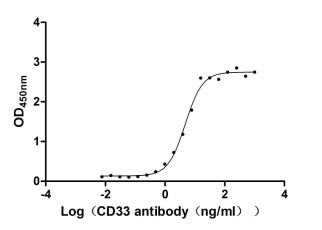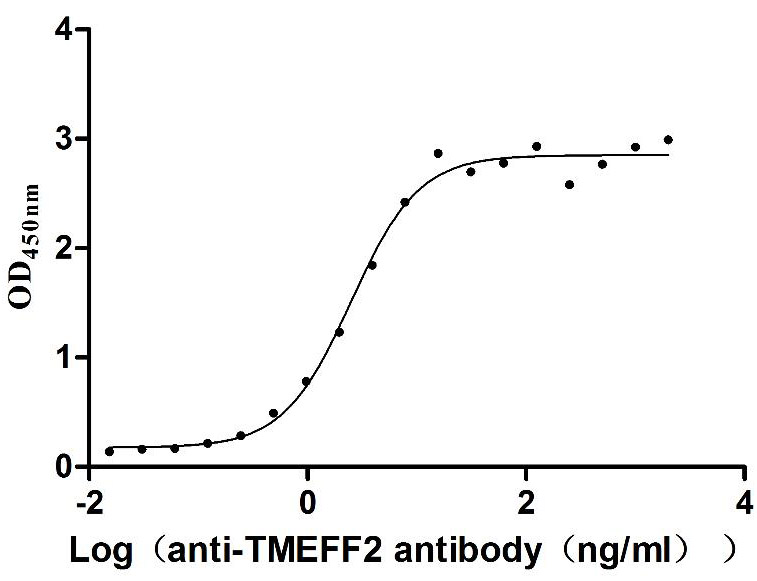Recombinant Influenza A virus Non-structural protein 1 (NS)
-
中文名称:Recombinant Influenza A virus Non-structural protein 1(NS),Yeast
-
货号:CSB-YP365961IFZ
-
规格:
-
来源:Yeast
-
其他:
-
中文名称:Recombinant Influenza A virus Non-structural protein 1(NS),Yeast
-
货号:CSB-EP365961IFZ
-
规格:
-
来源:E.coli
-
其他:
-
中文名称:Recombinant Influenza A virus Non-structural protein 1(NS),Yeast
-
货号:CSB-EP365961IFZ-B
-
规格:
-
来源:E.coli
-
共轭:Avi-tag Biotinylated
E. coli biotin ligase (BirA) is highly specific in covalently attaching biotin to the 15 amino acid AviTag peptide. This recombinant protein was biotinylated in vivo by AviTag-BirA technology, which method is BriA catalyzes amide linkage between the biotin and the specific lysine of the AviTag.
-
其他:
-
中文名称:Recombinant Influenza A virus Non-structural protein 1(NS),Yeast
-
货号:CSB-BP365961IFZ
-
规格:
-
来源:Baculovirus
-
其他:
-
中文名称:Recombinant Influenza A virus Non-structural protein 1(NS),Yeast
-
货号:CSB-MP365961IFZ
-
规格:
-
来源:Mammalian cell
-
其他:
产品详情
-
纯度:>85% (SDS-PAGE)
-
基因名:NS
-
Uniprot No.:
-
别名:NS; Non-structural protein 1; NS1; NS1A
-
种属:Influenza A virus (strain A/Puerto Rico/8/1934 H1N1)
-
蛋白长度:full length protein
-
表达区域:1-230
-
氨基酸序列MDPNTVSSFQ VDCFLWHVRK RVADQELGDA PFLDRLRRDQ KSLRGRGSTL GLDIETATRA GKQIVERILK EESDEALKMT MASVPASRYL TDMTLEEMSR DWSMLIPKQK VAGPLCIRMD QAIMDKNIIL KANFSVIFDR LETLILLRAF TEEGAIVGEI SPLPSLPGHT AEDVKNAVGV LIGGLEWNDN TVRVSETLQR FAWRSSNENG RPPLTPKQKR EMAGTIRSEV
-
蛋白标签:Tag type will be determined during the manufacturing process.
The tag type will be determined during production process. If you have specified tag type, please tell us and we will develop the specified tag preferentially. -
产品提供形式:Lyophilized powder
Note: We will preferentially ship the format that we have in stock, however, if you have any special requirement for the format, please remark your requirement when placing the order, we will prepare according to your demand. -
复溶:We recommend that this vial be briefly centrifuged prior to opening to bring the contents to the bottom. Please reconstitute protein in deionized sterile water to a concentration of 0.1-1.0 mg/mL.We recommend to add 5-50% of glycerol (final concentration) and aliquot for long-term storage at -20℃/-80℃. Our default final concentration of glycerol is 50%. Customers could use it as reference.
-
储存条件:Store at -20°C/-80°C upon receipt, aliquoting is necessary for mutiple use. Avoid repeated freeze-thaw cycles.
-
保质期:The shelf life is related to many factors, storage state, buffer ingredients, storage temperature and the stability of the protein itself.
Generally, the shelf life of liquid form is 6 months at -20°C/-80°C. The shelf life of lyophilized form is 12 months at -20°C/-80°C. -
货期:Delivery time may differ from different purchasing way or location, please kindly consult your local distributors for specific delivery time.Note: All of our proteins are default shipped with normal blue ice packs, if you request to ship with dry ice, please communicate with us in advance and extra fees will be charged.
-
注意事项:Repeated freezing and thawing is not recommended. Store working aliquots at 4°C for up to one week.
-
Datasheet :Please contact us to get it.
靶点详情
-
功能:Prevents the establishment of the cellular antiviral state by inhibiting TRIM25-mediated DDX58 ubiquitination, which normally triggers the antiviral transduction signal that leads to the activation of type I IFN genes by transcription factors IRF3 and IRF7. Prevents human EIF2AK2/PKR activation, either by binding double-strand RNA, or by interacting directly with EIF2AK2/PKR. This function may be important at the very beginning of the infection, when NS1 is mainly present in the cytoplasm. Also binds poly(A) and U6 snRNA.; Inhibits post-transcriptional processing of cellular pre-mRNA, by binding and inhibiting two cellular proteins that are required for the 3'-end processing of cellular pre-mRNAs: the 30 kDa cleavage and polyadenylation specificity factor/CPSF4 and the poly(A)-binding protein 2/PABPN1. In turn, unprocessed 3' end pre-mRNAs accumulate in the host nucleus and are no longer exported to the cytoplasm. Cellular protein synthesis is thereby shut off very early after virus infection. Viral protein synthesis is not affected by the inhibition of the cellular 3' end processing machinery because the poly(A) tails of viral mRNAs are produced by the viral polymerase through a stuttering mechanism.
-
基因功能参考文献:
- A recombinant pandemic H1N1 virus containing PA, PA-X, and NS1 genes from currently circulating viruses is fitter in replication in cultured cells and in mice and is slightly more pathogenic than the original ancestor pandemic H1N1 virus. PMID: 30021892
- Results confirm that Influenza A virus (IAV) mutant lacking NS1 differs from wild-type in that it induces the production of readily detectable levels of Dicer-dependent viral siRNAs in infected human cells. However, data also demonstrate that these siRNAs have little if any inhibitory effect on IAV gene expression. This is likely due, at least in part, to their inefficient loading into RNA-induced silencing complexes. PMID: 29903832
- Study found that the viral NS1 protein directly interacted with cellular Rac1 and facilitated viral replication. Further research revealed that NS1 down-regulated Rac1 activity via post-translational modifications. PMID: 27869202
- NS1-mediated JNK activation and apoptosis induction are functionally independent from each other in vivo. PMID: 28076660
- Mutations at position 171 in the NS1 protein result in decreased expression of IFN and ISGs by A549 cells. PMID: 28757142
- Optimal control of host protein synthesis by Influenza A viruses (IAVs) PA-X and/or NS1 proteins is required for efficient IAV replication in the host. PMID: 28637750
- The G45R mutation in the NS1 of H1N1 virus is critical for the enhanced viral replication in A549 cells. PMID: 27405392
- NS1 facilitates late viral gene expression by acting as an adaptor between viral mRNAs and the cellular nuclear export machinery to promote their nuclear export. PMID: 28515301
- data establish a model in which the Influenza A virus NS1 N-terminal domain engages in a binding interaction to inhibit activation of PKR and ensure efficient viral propagation and virulence PMID: 28250123
- Influenza a virus NS1 has a role in inducing A20 contributes to viral replication by suppressing interferon-induced antiviral response PMID: 27914808
- NF90 exerts its antiviral activity by antagonizing the inhibitory role of NS1 on PKR phosphorylation PMID: 27423063
- this study shows that influenza virus upregulated CTHRC1 expression through its NS1 protein PMID: 27718266
- Multifunctional NS1 protein is differentially phosphorylated throughout the replication cycle and that phospho-modification at threonine 49 acts as a molecular switch that alters NS1 activity. PMID: 26687707
- The C terminus of NS1 protein of influenza H1N1 virus modulates antiviral responses in infected human macrophages. PMID: 25934792
- These data show that RNase L targets specific sites in both host and viral RNAs to restrict influenza virus replication when NS1 protein is disabled. PMID: 25540362
- Mutations in NS1 gene is associated with virulence. PMID: 24699508
- Data show that 4 drug-like compounds from traditional Chinese Medicine (TCM) database were selected as potential inhibitors for the cleavage and polyadenylation specific factor CPSF30-binding site of influenza A virus of non-structural protein 1 (NS1A). PMID: 24562912
- A mutant virus with deletion of NS1 induced high levels of IFN-I in control cells. PMID: 24899174
- In experimentally infected chickens, the NS1del8084 virus showed both an increased replication potential and an increased pathogenicity. This in vivo phenotype was correlated with a higher replicative efficiency in vitro. PMID: 24694396
- These results suggest that the PBM in the NS1 protein may determine viral persistence in the human and avian IAV interface. PMID: 24802398
- hnRNP A2/B1 plays an inhibitory role in the replication of influenza A virus through suppressing NS1 RNA/protein levels and NS1 mRNA nucleocytoplasmic translocation. PMID: 24418537
- Data indicate that strains of the 2009 H1N1 pandemic influenza A virus could be divided into two categories based on the V123I mutation in the NS1 gene G1 and G2. PMID: 23418535
- This observation indicates the existence of an optimal level of NS1 SUMOylation that allows NS1 to achieve maximal activity. PMID: 23468495
- The NS1 protein of influenza A virus interacts with cellular processing bodies and stress granules through RNA-associated protein 55 (RAP55) during virus infection. PMID: 22973032
- NS1-W187R protein exhibited lower double-stranded RNA (dsRNA)-binding activity, showed a temporal redistribution during infection, and was minimally compromised for interferon antagonism. PMID: 22993153
- Mutations in the M-gene segment can substantially increase replication efficiency of NS1 deletion influenza A virus in MDCK cells PMID: 22951840
- Data show that infection of melanoma cells with delNS1-IL-15 resulted in the production of high levels of biologically active IL-15. PMID: 22563505
- There are commonalities but also functional differences in the roles of NS1 and E3 as inhibitors of the innate antiviral response. PMID: 22174864
- RNA helicase A as a cellular factor that interacts with influenza A virus NS1 protein and its role in the virus life cycle. PMID: 22171255
- The C-terminal 11-aa truncation in NS1 did not significantly alter virus replication, but increased virus pathogenicity in mice. PMID: 22022552
- Viral NS1-mediated delay of type I interferon induction contributes to influenza A virulence. PMID: 21411677
- Results allowed visualization of NS1 protein nuclear import in virus-infected cells in real time. PMID: 20463066
- The data obtained in this study demonstrate that the non-structural influenza A viral protein NS1A is an authentic SUMO target. PMID: 19917317
- RIG-I is required for induction of IFN-I in an influenza A virus (IAV)-infected human lung epithelial cell line. PMID: 17053203
- Our results indicate that, in addition to sequestering dsRNA, the NS1 of influenza A virus binds to RIG-I and inhibits downstream activation of IRF-3, preventing the transcriptional induction of IFN-beta. PMID: 17079289
- Mutant viruses carrying NS1 with mutations in SH3 binding motif 1 failed to interact with p85ss and induce the subsequent activation of PI3K/Akt pathway. PMID: 17881440
- These data suggest a model by which NS1 activates PI3K catalytic activity by masking a normal regulatory element specific to the p85beta inter-SH2 domain. PMID: 18029356
- These results suggest that NS1-2 recognizes the U6 snRNA in a similar manner to NS1 protein. PMID: 18039687
- Viral nonstructural protein 1 inhibits activation of RIG-I by binding to TRIM25. PMID: 19454344
- NS1 inhibits TRIM25-mediated RIG-I ubiquitination, thereby suppressing RIG-I signal transduction. PMID: 19454348
- influenza virus uses the NS1 protein to replicate for almost 2 days after infection before detection by the immune system. PMID: 19717515
- Mutants of a highly virulent variant of A/PR/8/34 (H1N1) carrying either a complete deletion or C-terminal truncations of NS1 were far more potent inducers of IFN in infected mice than NS1 mutants derived from standard A/PR/8/34. PMID: 19726611
显示更多
收起更多
-
亚细胞定位:Host nucleus. Host cytoplasm.
-
蛋白家族:Influenza A viruses NS1 family
-
数据库链接:
KEGG: vg:956533
Most popular with customers
-
Recombinant Human Myeloid cell surface antigen CD33 (CD33), partial (Active)
Express system: Mammalian cell
Species: Homo sapiens (Human)
-
Recombinant Human Cannabinoid receptor 1 (CNR1)-VLPs (Active)
Express system: Mammalian cell
Species: Homo sapiens (Human)
-
Recombinant Human Glucagon-like peptide 1 receptor (GLP1R), partial (Active)
Express system: Mammalian cell
Species: Homo sapiens (Human)
-
Recombinant Human Dickkopf-related protein 1 (DKK1) (Active)
Express system: Mammalian cell
Species: Homo sapiens (Human)
-
Recombinant Human Tomoregulin-2 (TMEFF2), partial (Active)
Express system: Mammalian cell
Species: Homo sapiens (Human)
-
Recombinant Human Cytotoxic and regulatory T-cell molecule (CRTAM), partial (Active)
Express system: Mammalian cell
Species: Homo sapiens (Human)
-
Recombinant Human Carcinoembryonic antigen-related cell adhesion molecule 8(CEACAM8) (Active)
Express system: Mammalian cell
Species: Homo sapiens (Human)





-AC1.jpg)













